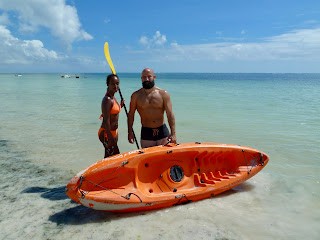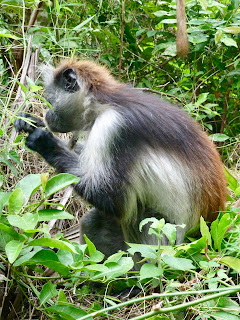3rd - 6th Nov 2020
 |
| Zanzibar Red Colobus monkey |
On arrival at the African Paradise hotel at Bwejuu I was greeted warmly by the owners, Pia and Hashim. They are Turkish and the hotel was recommended by their fellow Turk, Ahmed, in Nungwi. It was a great recommendation. They are a charming couple and nothing was too much trouble, and at a very reasonable price.
I had been having trouble with my computer, often due to Government restrictions on all matters Google, which had been most irritating. By good fortune Hashim is a computer whizz and sorted me out on a VPN network which got round the problem.
I showed a photo of this marvellous little beachside hotel on the previous blog. This (left) is a view from the outside dining area towards the sea at, just about, high tide. As mentioned previously it retreats about a mile when out. You can paddle out a long way in up to only 3 or 4 feet of water.
On day one I took a walk south down the beach, about 2 miles, to the small town of Paje and back. It was a lovely walk on the pristine white sand. Paje does not have a lot to offer other than beach hotels (rather lacking in guests at the moment) and this (right) rather pleasant roof-top bar (not many places sell alcohol here but this one does, plus a good 'spag bol') but there is an ATM cash machine at the local petrol station. These are not so common and cash is needed in most places. It (the ATM) is one of those which sucks your card in. I always have a fear of these because it may not reappear. I had a problem with one in Stone Town which did spit my card out, eventually, after lots of rumbling noises, but no cash! My card was charged, but then, fortunately, reimbursed. There are approx 3000 Tanzanian Shillings (TZS) to the £. On this occasion I had no problem, except all the machines charge you TZS17,500 (£6) for each transaction regardless of the amount you withdraw. Rip-off. There was a young chap, French as it transpired, who was sitting rather disconsolately on a window ledge outside the ATM. I said 'hello'. He said 'allo'. Apparently his card had been sucked in and not spat out. He had been waiting for 2 hours for someone, supposedly, to come along and retrieve it. Quel domage et catastrophe! He is probably still there. You can see why I worry.
Right: A local in traditional Muslim garb. This town, Paje, seems particularly Muslim oriented. As maybe mentioned, in most parts of the island there is a general population mix of Arab, African and Indian (and tourist). Read the complicated history.
Have I mentioned the Zanzibar Revolution of 1964? Quite horrific. You can read about it on Wikipedia. It was a significant, and gruesome, changing point in Zanzibar's recent past.
Left: A Massai I met on the way and we had a chat. The Massai (that I have met) are incredibly polite, often speak good English and, unlike some locals who can be a persistant pain in the arse trying to sell you something, are undemanding and interesting company. They are proud of their history and traditions.
Right: 'The Garage, Lodge and Bar' on the edge of town. I'm not sure what its customer base is but I doubt it will be receiving too many Michelin stars in the near future.
The hotel offered the free use of bicyles and canoes. I chose a bike and rode it down to Paje a couple of times on the hard white sand nearer the sea and it was quite easy going. There are locals on bicycles and scooters going up and down the beach.
Left: Parked for a breather under an impressively horizontal palm tree.
I returned on the main road which was easier going, but one had to be wary of some erratic traffic, especially with my erratic bike riding.
Right: This couple, Thomas (Swiss) and Rita (Rwandan), amusing fellow guests and also ex-Babalao, Nungwi, residents, chose a canoe. It was interesting to note that Rita was about to do the paddling. A fit couple!
Left: A poor pic of a young lad (white shorts, blue shirt) shinning up one of the palm trees by the hotel. (I discovered, belatedly, that camera lenses steam up quickly coming from hot to cool, or is it vice versa). He shot up there like a rat up a drainpipe and then released several large coconuts. The tree is owned by a local villager and the land by the hotel, so they share the coconuts. Interestingly the 'climber's' technique here is to loop a rope around the tree with his hands, feet free, and use that to shuffle up. Another method involves a cloth tied between the ankles to grip the trunk and hands free. I'm sure some smartarse expert will let me know which is correct.
Right: Same lad in the fronds of another, more vertical, tree You can just make out his legs. They must have harvested about 20 coconuts. Very dangerous to stand too close. Those nuts come down with a skull-shattering thump!
I spent half a day on a visit to the Jozani-Chwaka National Park, about 10 miles west of Paje. It is a carefully controlled area with its own 'eco-system' and not entirely in keeping with the intersts of the local farmers. However, proceeds from visitors are distributed amongst them and they are therefore happy to help preserve it. More tourists are always needed.
It is a forested area and subject to saltwater flooding which has resulted in extensive mangrove swamps. Amongst much diverse flora and fauna it is home to the unique Zanzibar Red Colobus monkey (right). These devour tree leaves and shoots and therefore not popular with local farmers, but due to financial incentive they are now allowed to live in peace.
I joined a couple of Brits and we were led around a maze of jungle pathways by a very knowledgeable (and excellent English speaking) guide. He has been 'guiding' here for 25 years.
We were told not to get too close to the monkeys, but the monkeys, many of them, had other ideas. They were jumping all over and around us. Lively little bleeders. There were also many Sykes monkeys, bush-babies and other furry creatures.
Left: This one reminds me of someone.
Our guide had an encyclopedic knowledge of the flora and fauna and identified all the multitude of different trees and plants (lots of mahogany) with both local and Latin names, most of which (or the leaves thereof) have effective medical properties. Between them, they could cure everything from infertility, through asthma to diarrhea. You name it, he had a tree that could cure it. He didn't mention a Covid-19 cure, but I'm sure he could if pressed! This bug is hardly a topic of conversation here anyway.
Left: Our excellent guide (and I've sadly forgotten his name) with my two London based companions.
Right: There is a well constructed and extensive platform walkway throught the mangrove swamp. Millenia ago this island was under the sea and much of the ground rock is coral. We were given lots of detail about mangrove swamps and their eco-system, including the prolific burrowing crabs. Enough of the nature lesson, and I've forgotten most of it!
Left: A view along the beach ouside the hotel. Impressive. It puts many Western beaches to shame, and so free of pollution.
And people!
Right: The hotel night-watchman. Another good-humoured Massai called Emo.
Left: One of the hotel table mats. Quite original, I thought, and very useful if you wanted to go tracking wildlife..assuming they left their footprints of course.
This was a very relaxed and pleasant stay at the African Paradise hotel. Right: Our genial and efficient hosts, Hashim and Pia. Many thanks to them.
Now back to Stone Town. There are many other places to visit there as so many were closed when I first arrived. The Freddie Mercury museum springs to mind! In any event it is a nice place to be.





















Thank you very much for choosing our hotel :) It was a great pleasure to meet you. We hope to see you soon :)
ReplyDelete